Effect of Drought on Outbreaks of Major Forest Pests, Pine Caterpillars (Dendrolimus spp.), in Shandong Province, China
Abstract
1. Introduction
2. Materials and Methods
2.1. Study Area
2.2. Data Sources
2.3. Calculations
2.3.1. Standard Precipitation Index
2.3.2. Hurst Exponent and Rescaled Range Analysis
2.3.3. Correlation, Linear Regression Analysis
3. Results
3.1. Variations of Drought in Shandong Province
3.2. Variations of the Outbreak of Pine Caterpillars in Shandong Province
3.3. Drought Impacts on the Outbreak of Pine Caterpillars in Shandong Province
3.4. Future Trends in Drought and Pine Caterpillar Outbreaks in Shandong Province and the Consistency of Trends
4. Discussion
4.1. Effects of Drought on the Pine Caterpillar Outbreak
4.2. Future Trends, Consistency on Drought and Pine Caterpillar Outbreak
5. Conclusions
Author Contributions
Funding
Acknowledgments
Conflicts of Interest
References
- Stephanson, C.A.; Ribarik Coe, N. Impacts of Beech Bark Disease and Climate Change on American Beech. Forests 2017, 8, 155. [Google Scholar] [CrossRef]
- Li, X.F.; Guo, Z.B.; Zhao, H.Y.; Zhu, H.X.; Wang, P.; Zhai, M. Change of Dry and Wet Climate and Its Influence on Forest Fire in the Great Xing’an Mountains. J. Appl. Meteorol. Sci. 2018, 29, 619–629. [Google Scholar]
- Creeden, E.P.; Hicke, J.A.; Buotte, P.C. Climate, weather, and recent mountain pine beetle outbreaks in the western United States. Forest Ecol. Manag. 2014, 312, 239–251. [Google Scholar] [CrossRef]
- Li, Y.; Wu, J.G.; Xie, L.Y.; Zhou, Q.F. Relationship between the geographic distribution patterns of typical agricultural and forest pest species with climatic factors in China. Res. Environ. Sci. 2012, 25, 533–542. [Google Scholar]
- Hart, S.J.; Veblen, T.T.; Schneider, D.; Molotch, N.P. Summer and winter drought drive the initiation and spread of spruce beetle outbreak. Ecology 2017, 98, 2698–2707. [Google Scholar] [CrossRef] [PubMed]
- Marini, L.; Okland, B.; Joinsson, A.M.; Bentz, B.; Carroll, A. Climate drivers of bark beetle outbreak dynamics in Norway spruce forests. Ecography 2017, 40, 1426–1435. [Google Scholar] [CrossRef]
- Weed, A.S.; Ayres, M.P.; Hicke, J.A. Consequences of climate change for biotic disturbances in North American forests. Ecol. Monogr. 2013, 83, 441–470. [Google Scholar] [CrossRef]
- Netherer, S.; Schopf, A. Potential effects of climate change on insect herbivores in European forests—General aspects and the pine processionary moth as specific example. Forest Ecol. Manag. 2010, 259, 831–838. [Google Scholar] [CrossRef]
- Zeng, J.P.; Ge, F.; Su, J.W.; He, Z. Researches on the Occurrences of Major Forest Insect Pests of Pine Caterpillar Dendrolimus spp. in China. Chinese J. Appl. Entomol. 2010, 47, 451–459. [Google Scholar]
- Wang, F.; Wu, D.J.; Zhai, G.F.; Zang, L.H. Diagnosing Low Health and Wood Borer Attacked Trees of Chinese Arborvitae by Using Thermography. Spectrosc. Spect. Anal. 2015, 35, 3410–3415. [Google Scholar]
- Liu, X.F.; Pan, Y.Z.; Zhu, X.F.; Yang, T.T.; Bai, J.J.; Sun, Z.L. Drought evolution and its impact on the crop yield in the North China Plain. J. Hydrol. 2018, 564, 984–996. [Google Scholar] [CrossRef]
- Li, C.; Filho, W.L.; Yin, J. Assessing vegetation response to multi-time-scale drought across Inner Mongolia plateau. J. Clean. Prod. 2018, 179, 210–216. [Google Scholar] [CrossRef]
- Saksa, P.; Safeeq, M.; Dymond, S. Recent Patterns in Climate, Vegetation, and Forest Water Use in California Montane Watersheds. Forests 2017, 8, 278. [Google Scholar] [CrossRef]
- Peña-Gallard, M.; Vicente-Serrano, S.; Camarero, J.; Gazol, A. Drought Sensitiveness on Forest Growth in Peninsular Spain and the Balearic Islands. Forests 2018, 9, 524. [Google Scholar] [CrossRef]
- Palmer, W.C. Meteorological Drought; U.S. Department of Commerce Bureau Research Paper: Washington, DC, USA, 1965; p. 58.
- Mishra, A.K.; Singh, V.P. A review of drought concepts. J. Hydrol. 2010, 391, 202–216. [Google Scholar] [CrossRef]
- Mirabbasi, R.; Anagnostou, E.N.; Fakheri-Fard, A.; Dinpashoha, Y. Analysis of meteorological drought in northwest Iran using the Joint Deficit Index. J. Hydrol. 2013, 492, 35–48. [Google Scholar] [CrossRef]
- Farahmand, A.; Aghakouchak, A.; Teixeira, J. A Vantage from Space Can Detect Earlier Drought Onset: An Approach Using Relative Humidity. Sci Rep. 2015, 5, 8553. [Google Scholar] [CrossRef] [PubMed]
- Zhang, L.; Li, J. Spatiotemporal Change of Drought at Various Time Scales Indicated by SPEI and SPI in Xijiang River Basin. Plateau Meteorol. 2018, 37, 560–567. [Google Scholar]
- Vicente-Serrano, S.M.; Beguería, S.; López-Moreno, J.I. A Multiscalar Drought Index Sensitive to Global Warming: The Standardized Precipitation Evapotranspiration Index. J. Clim. 2010, 23, 1696–1718. [Google Scholar] [CrossRef]
- Martinez-Fernandez, J.; Gonzalez-Zamora, A.; Sanchez, N.; Gumuzzio, A. Satellite soil moisture for agricultural drought monitoring: Assessment of the SMOS derived Soil Water Deficit Index. Remote Sens. Environ. 2016, 177, 277–286. [Google Scholar]
- Guo, E.; Liu, X.; Zhang, J.; Wang, Y. Assessing spatiotemporal variation of drought and its impact on maize yield in Northeast China. J. Hydrol. 2017, 553, 231–247. [Google Scholar] [CrossRef]
- Chen, L.; Huang, J.; Alam, S.A.; Zhai, L. Drought causes reduced growth of trembling aspen in western Canada. Glob. Chang. Biol. 2017, 23, 2887–2902. [Google Scholar] [CrossRef] [PubMed]
- Khan, M.I.; Liu, D.; Fu, Q. Projected Changes of Future Extreme Drought Events under Numerous Drought Indices in the Heilongjiang Province of China. Water Resour. Manag. 2017, 31, 3921–3937. [Google Scholar] [CrossRef]
- Hayes, M.; Svoboda, M.; Wall, N.; Widhalm, M. The Lincoln Declaration on Drought Indices: Universal Meteorological Drought Index Recommended. B. Am. Meteorol. Soc. 2011, 92, 485–488. [Google Scholar] [CrossRef]
- Jactel, H.; Petit, J.; Desprez-Loustau, M.; Delzon, S. Drought effects on damage by forest insects and pathogens: a meta-analysis. Glob. Chang. Biol. 2015, 18, 267–276. [Google Scholar] [CrossRef]
- Zhu, Q.L. Investigation and risk assessment of forest pest in three cities of Shandong Province. Master’s Thesis, Shandong Agricultural University, Jinan, China, 2016; pp. 9–12. [Google Scholar]
- He, Z.M.; Zhao, J.B. Change of extreme air temperature in east of Shandong Province during 1961-2014. J. Nat. Disasters 2017, 26, 123–133. [Google Scholar]
- Han, R.; Bao, W.; Zhao, M.; Li, J. Temperature Change and Its Influence on Thermal Conditions of Agriculture in Shandong: Based on Data of 52 Years. Chin. Agr. Sci. B. 2017, 33, 112–122. [Google Scholar]
- Mckee, T.B.; Doesken, N.J.; Kleist, J. The Relationship of Drought Frequency and Duration to Time Scales. In Proceedings of the 8th Conference on Applied Climatology, Anaheim, CA, USA, 17–22 January 1993. [Google Scholar]
- Bonaccorso, B.; Bordi, I.; Cancelliere, A.; Sutera, A. Spatial Variability of Drought: An Analysis of the SPI in Sicily. Water Resour. Manag. 2003, 17, 273–296. [Google Scholar] [CrossRef]
- Gidey, E.; Dikinya, O.; Sebego, R.; Segosebe, E. Modeling the Spatio-Temporal Meteorological Drought Characteristics Using the Standardized Precipitation Index (SPI) in Raya and Its Environs, Northern Ethiopia. Earth Syst. Environ. 2018, 2, 281–292. [Google Scholar] [CrossRef]
- Tong, S.; Lai, Q.; Zhang, J.; Bao, Y. Spatiotemporal drought variability on the Mongolian Plateau from 1980-2014 based on the SPEI-PM, intensity analysis and Hurst exponent. Sci. Total Environ. 2018, 615, 1557–1565. [Google Scholar] [CrossRef] [PubMed]
- Hurst, E.H. Long-term storage capacity of reservoirs. Trans. Am. Soc. Civ. Eng. 1951, 116, 770–808. [Google Scholar]
- Hu, D.X.; Li, L.; Zhang, Y.; Xiong, J.L. Water Quality Change Before and After Comprehensive Treatment in Shanxi Section of Weihe Main Stream. B. Soil Water Conversat. 2018, 38, 91–96. [Google Scholar]
- Bogino, S.M.; Bravo, F. Growth response of Pinus pinaster Ait. to climatic variables in central Spanish forests. Ann. For. Sci. 2008, 65, 506. [Google Scholar] [CrossRef]
- Preisler, H.K.; Hicke, J.A.; Ager, A.A.; Hayes, J.J. Climate and weather influences on spatial temporal patterns of mountain pine beetle populations in Washington and Oregon. Ecology 2012, 93, 2421–2434. [Google Scholar] [CrossRef] [PubMed]
- Williams, A.P.; Allen, C.D.; Macalady, A.K.; Griffin, D. Temperature as a potent driver of regional forest drought stress and tree mortality. Nat. Clim. Chang. 2013, 3, 292–297. [Google Scholar] [CrossRef]
- Zhang, J.; Liu, X. Introduction of Integrated Disaster Risk Management. Peking University Press: Beijing, China, 2012; pp. 75–82. [Google Scholar]
- Kolb, T.E.; Fettig, C.J.; Ayres, M.P.; Bentz, B.J. Observed and anticipated impacts of drought on forest insects and diseases in the United States. Forest Ecol. Manag. 2016, 380, 321–334. [Google Scholar] [CrossRef]
- Dai, Y.X. Water balance-carbon metabolism relations of different tree species under drought and forest adverse conditions. Ph.D. Thesis, Chinese Academy of Forestry, Beijing, China, 2017; pp. 18–27. [Google Scholar]
- Mcdowell, N.; Pockman, W.T.; Allen, C.D. Mechanisms of plant survival and mortality during drought: Why do some plants survive while others succumb to drought? New Phytol. 2008, 178, 719–739. [Google Scholar] [CrossRef] [PubMed]
- Mcdowell, N. Mechanisms linking drought, hydraulics, carbon metabolism, and vegetation mortality. Plant Physiol. 2011, 155, 1051–1059. [Google Scholar] [CrossRef] [PubMed]
- Anderegg, W.R.; Callaway, E.S. Infestation and Hydraulic Consequences of Induced Carbon Starvation. Plant Physiol. 2012, 159, 1866–1874. [Google Scholar] [CrossRef] [PubMed]
- Gleason, S.M.; Ares, A. Photosynthesis, carbohydrate storage and survival of a native and an introduced tree species in relation to light and defoliation. Tree Physiol. 2004, 24, 1087–1097. [Google Scholar] [CrossRef] [PubMed]
- Dong, L.; Li, J. Relationship among drought, hydraulic metabolic, carbon starvation and vegetation mortality. Acta Ecol. Sin. 2013, 33, 5477–5483. [Google Scholar] [CrossRef]
- Sevanto, S.; Mcdowell, N.; Dickman, L.T.; Pangle, R. How do trees die? A test of the hydraulic failure and carbon starvation hypotheses. Plant Cell Environ. 2014, 37, 153–161. [Google Scholar] [CrossRef] [PubMed]
- Mattson, W.J.; Haack, R.A. The role of drought in outbreaks of plant-eating insects. BioScience 1987, 37, 110–118. [Google Scholar] [CrossRef]
- White, T.C.R. The Abundance of Invertebrate Herbivores in Relation to the Availability of Nitrogen in Stressed Food Plants. Oecologia 1984, 63, 90–105. [Google Scholar] [CrossRef] [PubMed]
- Luo, D.; Yang, Y.; Xu, H.; Zheng, X. Minireview on the influences of drought stress on herbivores and their natural enemies. J. Enviro. Entomol. 2012, 34, 228–229. [Google Scholar]
- Bentz, B.J.; Regniere, J.; Fettig, C.J.; Hansen, E.M. Climate Change and Bark Beetles of the Western United States and Canada: Direct and Indirect Effects. Bioscience 2010, 60, 602–613. [Google Scholar] [CrossRef]
- Arango-Velez, A.; Galindo, L.M.; Meents, M.J.; Kayal, W.E. Influence of water deficit on the molecular responses of Pinus contorta × Pinus banksiana mature trees to infection by the mountain pine beetle fungal associate, Grosmannia clavigera. Tree Physiol. 2014, 34, 1220–1239. [Google Scholar] [CrossRef] [PubMed]
- Coley, P.D. Possible effects of climate change on plant/herbivore interactions in moist tropical forests. Clim. Chang. 1998, 39, 455–472. [Google Scholar] [CrossRef]
- Wang, Y.; Yu, Z.; Wu, H. Main environmental factors for forestry insects that become important pests. J. Zhejiang For. Coll. 2007, 24, 752–757. [Google Scholar]
- Zhang, Z.; Li, D. Approach to Outbreak Mechanism of Dendrolimus punctatus (Lepidoptera: Lasiocampidae). Sci. Silvae Sinicae 2008, 44, 140–150. [Google Scholar]
- Brockerhoff, E.G.; Chinellato, F.; Faccoli, M.; Kimberley, M. Effects of elevation and aspect on the flight activity of two alien pine bark beetles (Coleoptera: Curculionidae, Scolytinae) in recently-harvested pine forests. Forest Ecol. Manag. 2017, 384, 132–136. [Google Scholar] [CrossRef]
- Zhang, L.; Xiao, J.; Zhou, Y.; Zheng, Y. Drought events and their effects on vegetation productivity in China. Ecosphere 2016, 7, e01591. [Google Scholar] [CrossRef]
- Sheng, C. On a Theory of Overcompensation of Crops and Its Importance to Insect Pest Control. J. Nat. Disasters 1993, 2, 12–19. [Google Scholar]
- Wang, W. The occurrence trend of grassland pests in Qinghai Province in 1993. Chin. Qinghai J. Anim. Vet. Sci. 1993, 23, 31–32. [Google Scholar]
- Wang, S. Loss of cotton pests in the United States in 1992. China Cotton 1993, 5, 14. [Google Scholar]
- Zhang, P.; Ye, Q.; Ouyang, F.; Peng, L. Global warming and droughts aggravate forest damage resulting from pests and diseases in Jiangxi Province. Acta Ecol. Sin. 2017, 37, 639–649. [Google Scholar]
- Ray, D.; Peace, A.; Moore, R.; Petr, M. Improved prediction of the climate-driven outbreaks of Dendrolimus pini in Pinus sylvestris forests. Forestry 2016, 89, 1–15. [Google Scholar] [CrossRef]
- Zhang, J.; Shen, Y. Spatio-temporal variations in extreme drought in China during 1961–2015. J. Geogr. Sci. 2019, 29, 67–83. [Google Scholar] [CrossRef]
- Mo, X.; Hu, S.; Lu, H.; Lin, Z. Drought Trends over the Terrestrial China in the 21st Century in Climate Change Scenarios with Ensemble GCM Projections. J. Nat. Resour. 2018, 33, 1244–1256. [Google Scholar]
- Xu, Z.; Han, M. Spatio-temporal distribution characteristics of drought in Shandong Province and it relationship with ENSO. Chinese J. Eco-Agr. 2018, 26, 1236–1248. [Google Scholar]
- Tong, S.; Zhang, J.; Bao, Y.; Lai, Q. Analyzing vegetation dynamic trend on the Mongolian Plateau based on the Hurst exponent and influencing factors from 1982–2013. J. Geogr. Sci. 2018, 28, 595–610. [Google Scholar] [CrossRef]
- Pureswaran, D.; Roques, A.; Battisti, A. Forest Insects and Climate Change. Curr. For. Rep. 2018, 4, 35–50. [Google Scholar] [CrossRef]

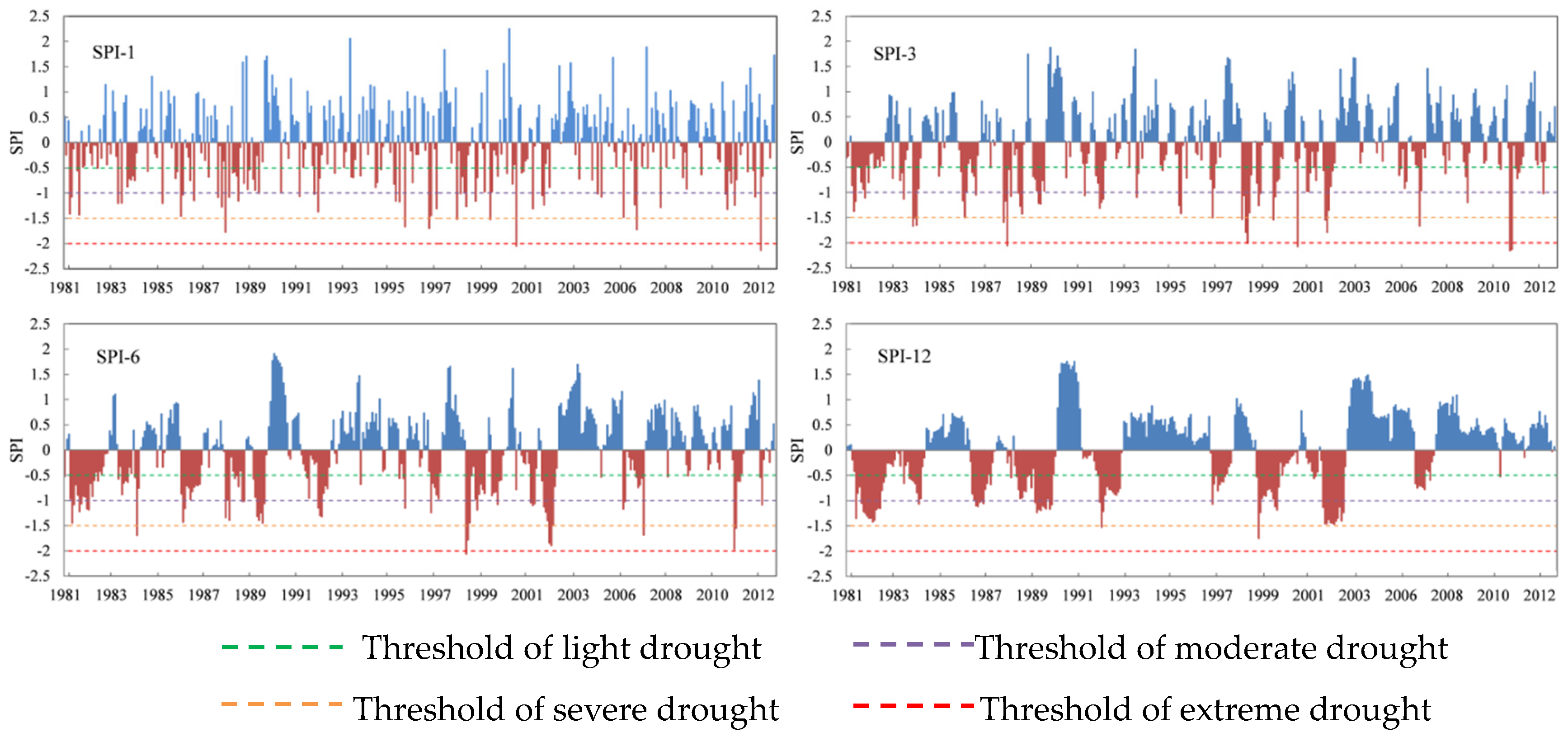

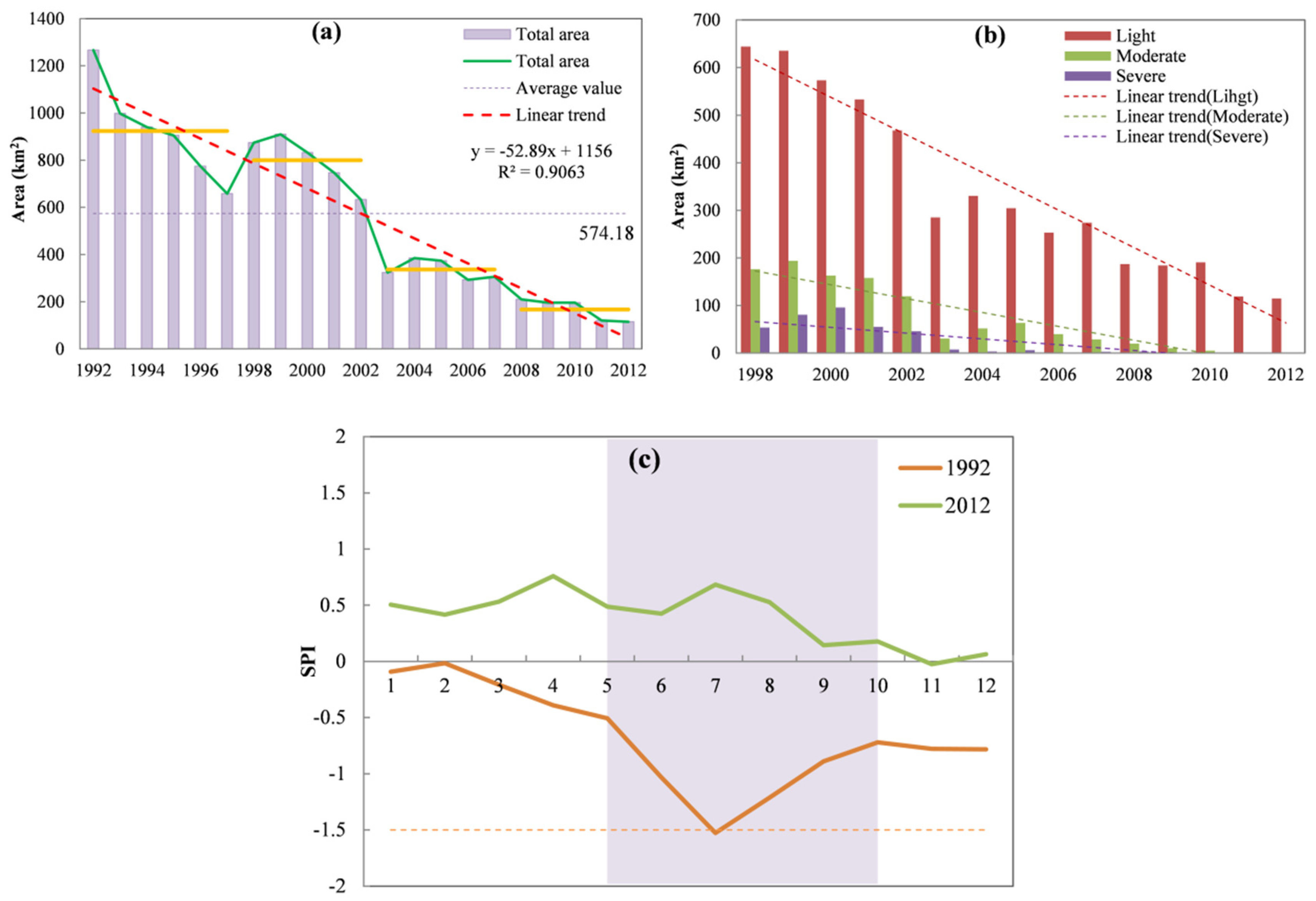
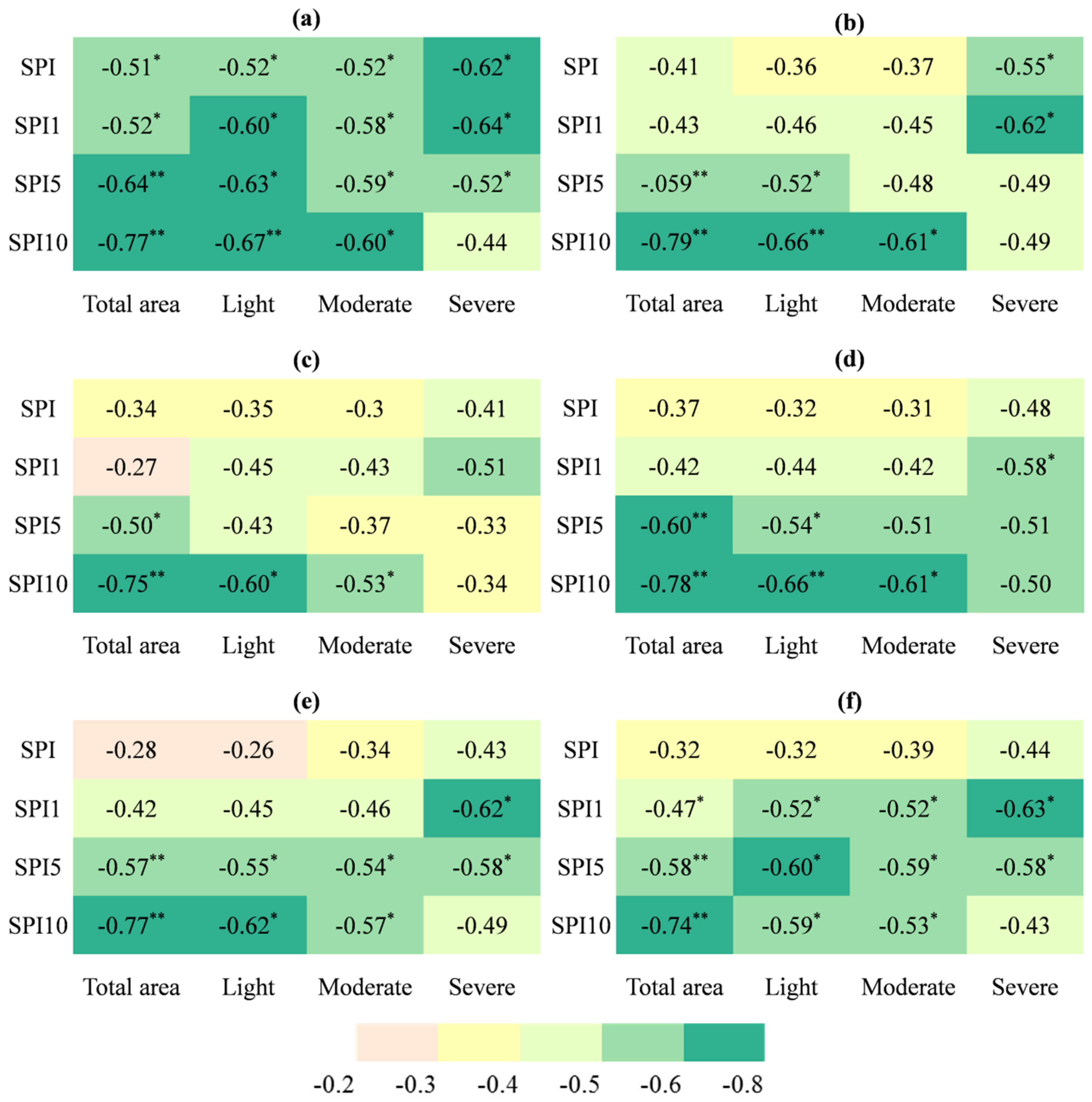
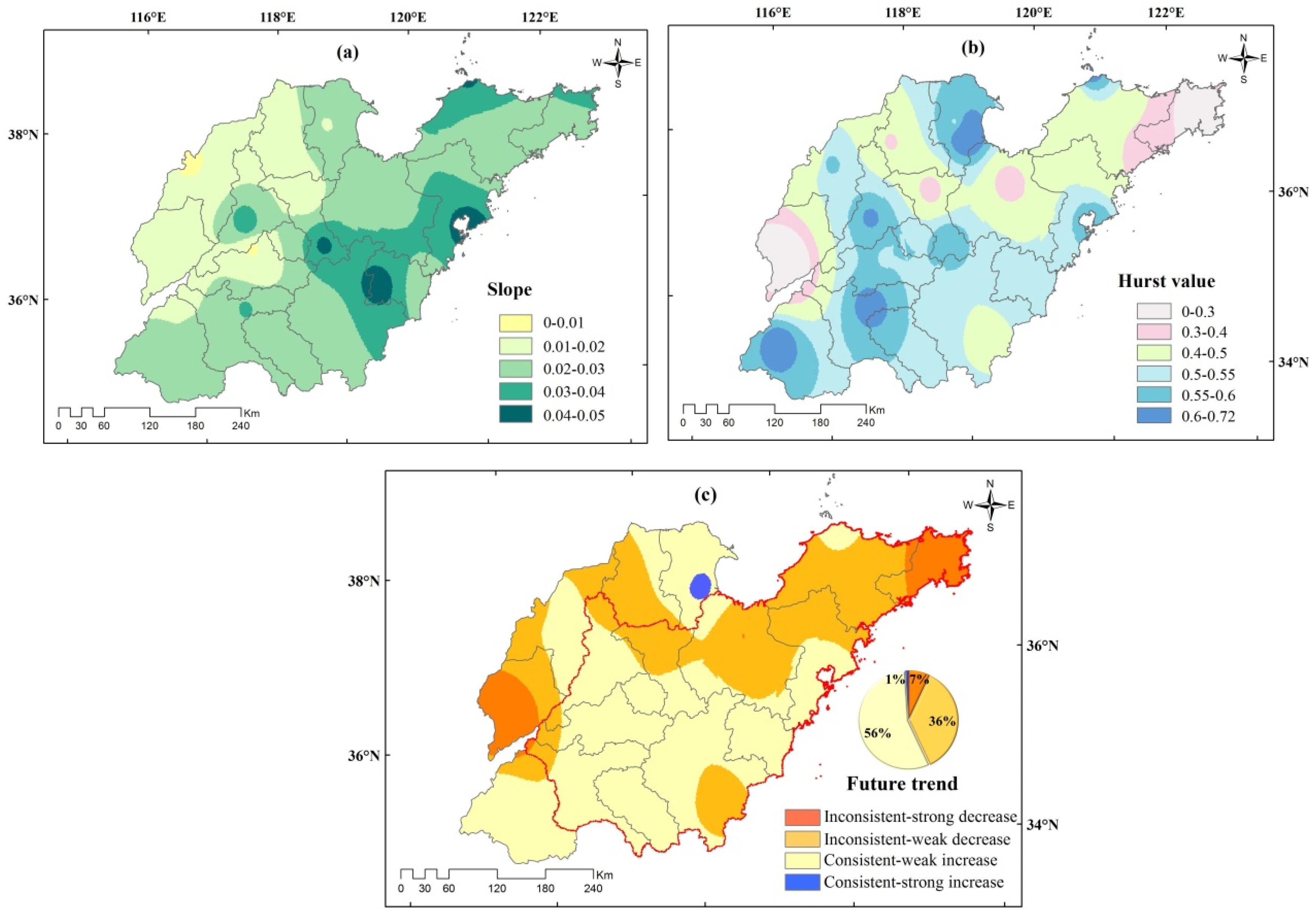
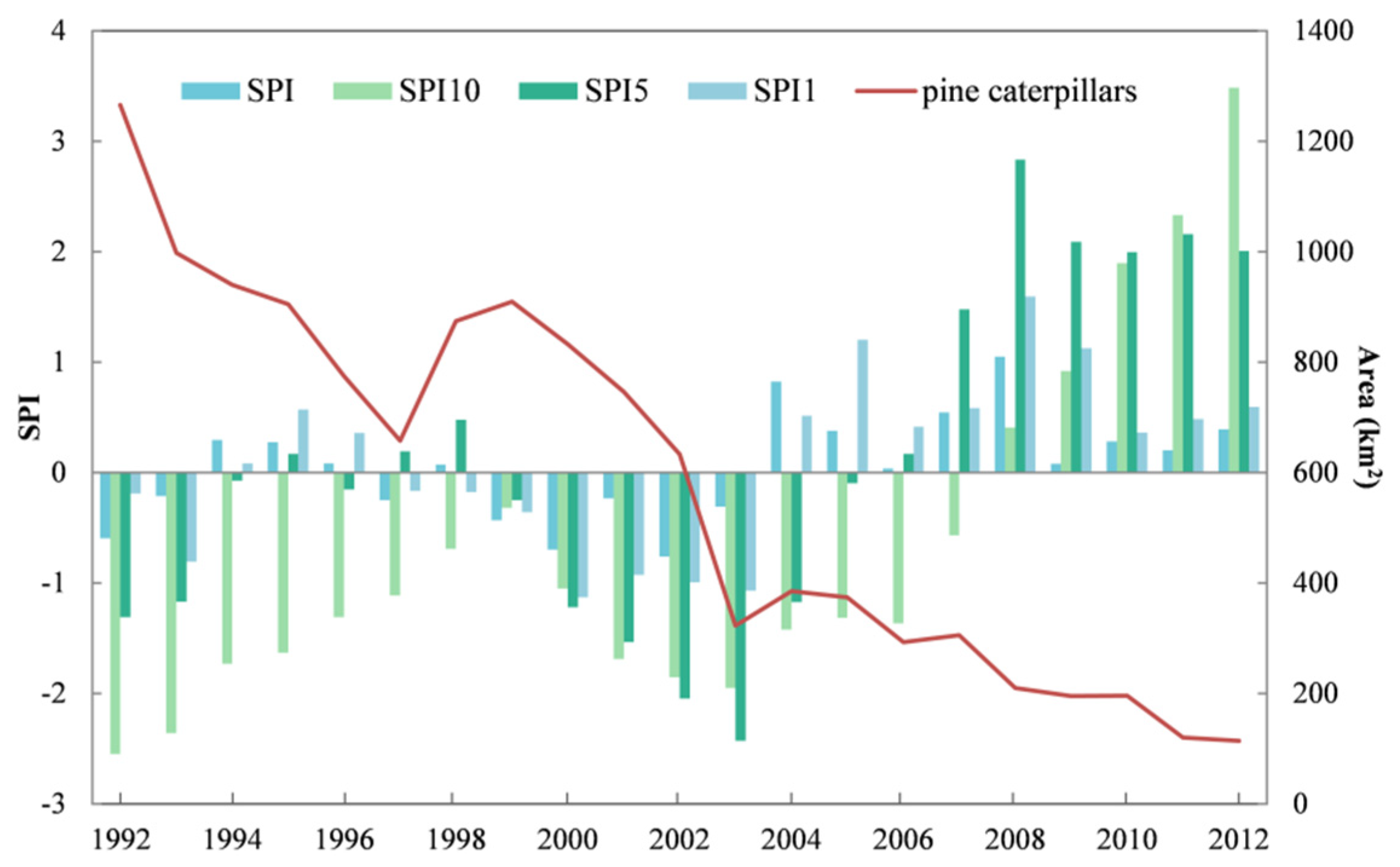
| SPI | Drought Class | H | Consistency |
|---|---|---|---|
| Moderate wet | Strong consistency | ||
| Normal | Weak consistency | ||
| Light drought | H = 0.5 | No relevance | |
| Moderate drought | Weak inconsistency | ||
| Severe drought | Strong inconsistency |
| Drought Category | Years |
|---|---|
| Light | 1983, 1984, 1986, 1987, 1988, 1993, 1997, 1999, 2001, 2003 |
| Moderate | 1981, 1982, 1989, 1992, 2000, 2002 |
| Pine Caterpillars | Linear Equation | R2 | Trend | H Value | Consistency |
|---|---|---|---|---|---|
| Total area | y = −52.98x + 1156 | 0.906 | ↓ ** | 0.923 | Consistent and strong decrease |
| Light | y = −39.49x + 655 | 0.922 | ↓ ** | 0.937 | Consistent and strong decrease |
| Moderate | y = −14.58x + 187 | 0.853 | ↓ ** | 0.935 | Consistent and strong decrease |
| Severe | y = −6.06x + 72 | 0.664 | ↓ ** | 0.948 | Consistent and strong decrease |
© 2019 by the authors. Licensee MDPI, Basel, Switzerland. This article is an open access article distributed under the terms and conditions of the Creative Commons Attribution (CC BY) license (http://creativecommons.org/licenses/by/4.0/).
Share and Cite
Bao, Y.; Wang, F.; Tong, S.; Na, L.; Han, A.; Zhang, J.; Bao, Y.; Han, Y.; Zhang, Q. Effect of Drought on Outbreaks of Major Forest Pests, Pine Caterpillars (Dendrolimus spp.), in Shandong Province, China. Forests 2019, 10, 264. https://doi.org/10.3390/f10030264
Bao Y, Wang F, Tong S, Na L, Han A, Zhang J, Bao Y, Han Y, Zhang Q. Effect of Drought on Outbreaks of Major Forest Pests, Pine Caterpillars (Dendrolimus spp.), in Shandong Province, China. Forests. 2019; 10(3):264. https://doi.org/10.3390/f10030264
Chicago/Turabian StyleBao, Yongbin, Fei Wang, Siqin Tong, Li Na, Aru Han, Jiquan Zhang, Yuhai Bao, Yunchi Han, and Qiumei Zhang. 2019. "Effect of Drought on Outbreaks of Major Forest Pests, Pine Caterpillars (Dendrolimus spp.), in Shandong Province, China" Forests 10, no. 3: 264. https://doi.org/10.3390/f10030264
APA StyleBao, Y., Wang, F., Tong, S., Na, L., Han, A., Zhang, J., Bao, Y., Han, Y., & Zhang, Q. (2019). Effect of Drought on Outbreaks of Major Forest Pests, Pine Caterpillars (Dendrolimus spp.), in Shandong Province, China. Forests, 10(3), 264. https://doi.org/10.3390/f10030264







